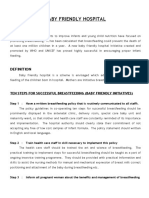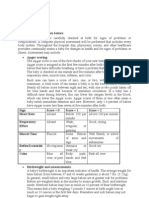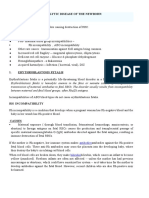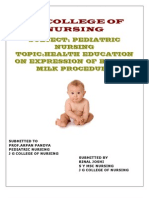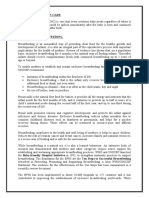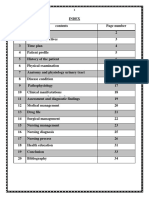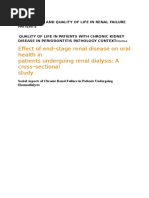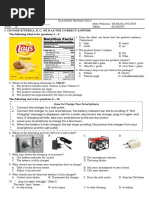Exclusive Breastfeeding
Exclusive Breastfeeding
Uploaded by
Dezttie IdEss NdessCopyright:
Available Formats
Exclusive Breastfeeding
Exclusive Breastfeeding
Uploaded by
Dezttie IdEss NdessOriginal Description:
Copyright
Available Formats
Share this document
Did you find this document useful?
Is this content inappropriate?
Copyright:
Available Formats
Exclusive Breastfeeding
Exclusive Breastfeeding
Uploaded by
Dezttie IdEss NdessCopyright:
Available Formats
Exclusive breastfeeding
Breastfeeding is an unequalled way of providing ideal food for the healthy growth and
development of infants; it is also an integral part of the reproductive process with important
implications for the health of mothers. Review of evidence has shown that, on a population basis,
exclusive breastfeeding for 6 months is the optimal way of feeding infants. Thereafter infants
should receive complementary foods with continued breastfeeding up to 2 years of age or
beyond.
WHO/NHD
To enable mothers to establish and sustain exclusive breastfeeding for 6 months, WHO and
UNICEF recommend:
Initiation of breastfeeding within the first hour of life
Exclusive breastfeeding that is the infant only receives breast milk without any
additional food or drink, not even water
Breastfeeding on demand that is as often as the child wants, day and night
No use of bottles, teats or pacifiers
Breast milk is the natural first food for babies, it provides all the energy and nutrients that the
infant needs for the first months of life, and it continues to provide up to half or more of a childs
nutritional needs during the second half of the first year, and up to one-third during the second
year of life.
Breast milk promotes sensory and cognitive development, and protects the infant against
infectious and chronic diseases. Exclusive breastfeeding reduces infant mortality due to common
childhood illnesses such as diarrhoea or pneumonia, and helps for a quicker recovery during
illness. These effects can be measured in resource-poor and affluent societies (Kramer M et al
Promotion of Breastfeeding Intervention Trial (PROBIT): A randomized trial in the Republic of
Belarus. Journal of the American Medical Association, 2001, 285(4): 413-420
Nutritional Composition of Breast Milk
breastfeeding milk
Thanks to scientists and baby-formula manufacturers, the nutritional composition
of breast milk has been de-mystified. So what exactly is in breast milk to make it the
"perfect food" for babies?
Fats:
The nutritional composition of breast milk begins with fat. If you take all the water out of
breast milk, half of what's left behind is fat. And, there's lots of cholesterol too. Dont
worry: babies, infants, and young children need fats because it is needed for the
development of the nervous system. Specifically, fats are need to cover & protective
nerve cells. They are also integral parts of cell membranes.
Researchers have found that breastfed babies grow up to be adults with lower cholesterol.
It is suggested that exposing babies to cholesterol in the breast milk allows their bodies to
learn how to regulate cholesterol so that as adults, they have lower cholesterol levels.
In breast milk, there is an enzyme called lipase. Lipase breaks down fat so that the fat is
in small globules. This allows for better digestion and absorption in Babys stomach.
In contrast, the fat globules in baby-formula are large because they are from cows milk
(cow's milk is used to make most formulas). The fat from cow's milk is not absorbed as
well by human babies. Formula manufacturers have tried to correct this by replacing
cows milk fat with plant oils (corn, coconut, olive, peanut, and others).
cholesterol and breast milk
The nutritional composition of breast milk includes fats and cholesterol. These
components are necessary for developing babies. Research published in the journal of
Pediatrics show that the high levels of cholesterol in breast milk may lead to lower levels
of cholesterol in adults. Photo from wikipedia.com
Carbohydrates
The next big component of breast milk is carbohydrates (37%). Most people know
carbohydrates as the macromolecule found in bread, pasta and rice. But in breast milk,
most of the carbohydrates are in the form of lactose. Lactose is a disaccharide: it is made
up of two sugars (galactose and glucose) linked together.
Lactose provides Baby with energy so that he can do the things that babies do: breath,
eat, cry, wriggle, poop, learn, grow, and develop.
Lactose is converted to lactic acid by the Lactobacillus (a naturally occurring gut
bacterium). The lactic acid makes Babys stomach acidic. This in turn prevents the
growth of harmful bacteria that are not supposed to be in Babys stomach.
Cows milk (used to make baby formula) has less than 10% lactose. Formulas
manufacturers try to match the nutritional composition of breast milk by adding more
lactose.
carbohydrates, lactose in breast milk
Lactose is a disaccharide composed of one glucose and one galactose unit. Lactose is the
predominant carbohydrate in breast milk. Photo from wikipedia.com
Proteins
There are high levels of protein in colostrum and the levels gradually decrease as Baby
grows older and older. By six months of age, Baby should get an external source of
protein, for example in baby cereals or other solid foods.
Mature milk has many different kinds of proteins but the two major players are whey and
casein. Whey is a smooth, liquidly-type of protein whereas casein is a coarse protein that
tends to curdle. In breast milk, 60% to 80% of the proteins are of the whey type. Whey is
easier to digest and it is absorbed well in Babys stomach. Because of this, babies fed on
breast milk will have runny poops, and be hungry more often.
Cows milk has more casein and less whey. Casein is harder to digest & absorb because it
clumps in Babys stomach. Formula-fed babies are hungry less often because the formula
isn't being digested. As well, when the Babies poop, the poops are more solid. Formula
manufacturers try to correct for this by adding emulsifiers to help break apart the casein.
Other than whey and casein, there are many other important proteins:
antibodies (helps fight against bacterial and viral infections),
lactoferrin (binds to iron and helps Baby absorb iron. It also prevents the growth of
harmful microorganisms that use iron),
bifidus factor (encourages the growth of lactobacillus which helps prevents the growth
of other harmful stomach bacteria),
lipase, amylase, lysozyme, and other enzymes (helps in digestion and creates a healthy
environment in Babys intestines).
proteins antibodies in breast milk
An antibody is a kind of protein. It is often shown as a Y-shaped molecule. Antibodies
work by binding to and incapacitating foreign particles such as bacteria. Photo from
wikipedia.com.
Vitamins, Minerals, and More
Breast milk contains vitamins and minerals which, for the most part, can be simulated in
formulas. However, the nutritional composition of breast milk includes over 100 different
components most of which we still do not know how they affect Babys growth and
development. Currently, formula manufactures have not been able to recreate, exactly,
the nutritional composition of breast milk. Click here to see the nutritional composition of
breast milk.
Benefits for baby
Breast milk is easily digested. Its immediately available and always fresh.
If you eat a healthy diet, then your breast milk provides baby with a perfect blend of
nutrients and protective antibodies (although it doesnt replace the need for
immunisations).
Breastfeeding helps your baby grow and develop physically and emotionally.
Breastfeeding and breast milk help protect your baby from chest infections, meningitis,
ear infections and urine infections.
Breastfeeding decreases the risk of sudden unexpected death in infancy (SUDI, also
known as sudden infant death syndrome or SIDS). Its also linked to lower hospitalisation
rates.
Breastfeeding and breast milk may protect baby from chronic tummy problems and some
childhood cancers. They may also be less likely to get allergies, eczema or asthma.
Breastfeeding helps reduce the risk of obesity and may help reduce the risk of diabetes in
later life.
Benefits for mothers
Breastfeeding helps you recover from birth.
Skin-to-skin contact is a wonderful way to start intimately connecting with your baby.
Breastfeeding reduces your risk of pre-menopausal breast cancer.
Breastfeeding may reduce your risk of ovarian cancer, osteoporosis and hip fracture later
in life.
Breastfeeding may help you lose weight gained during pregnancy.
Breastfeeding can be your motivation to start living a healthier lifestyle, and cut down on
smoking or drinking.
Exclusive breastfeeding
Exclusive breastfeeding is recommended until your baby is around six months old this
means that since birth, your baby has only had breast milk (from the breast or expressed)
and prescribed medicines.
If your baby is exclusively breastfed, then breast milk meets all their fluid requirements.
They dont need water or any other drinks or food until theyre around six months old.
After six months, exclusive breastfeeding is not enough for your baby to grow and
develop. You should introduce complementary foods (solids) and also continue
breastfeeding until theyre at least one year or older.
When youre away from your baby, try to ensure theyre fed with expressed breast milk
rather than infant formula.
You might also like
- Weight Training: by Calum Von MogerDocument24 pagesWeight Training: by Calum Von MogerJohn Rose100% (3)
- Immediate Newborn Care (Autosaved)Document183 pagesImmediate Newborn Care (Autosaved)mftaganas100% (2)
- Steroid CyclesDocument5 pagesSteroid Cycleswatermelontaco75% (4)
- The Big Fat Surprise by Nina TeicholzDocument12 pagesThe Big Fat Surprise by Nina Teicholzsimas50% (2)
- 1000 Rep MuscleDocument28 pages1000 Rep MuscleSwarna Khare100% (2)
- Year 9 Biology QuestionsDocument58 pagesYear 9 Biology QuestionsDuong Kha Nhi100% (1)
- Prolactin Reflex (Milk Secretion Reflex)Document16 pagesProlactin Reflex (Milk Secretion Reflex)Juhi Johnson JadhavNo ratings yet
- Exclusive BreastfeedingDocument11 pagesExclusive BreastfeedingTalitha SalsabilaNo ratings yet
- BFHIDocument10 pagesBFHIArchana Sahu100% (1)
- Baby Friendly Hospitals 2: Baby Friendly Hospitals 2Document2 pagesBaby Friendly Hospitals 2: Baby Friendly Hospitals 2faisal_7799No ratings yet
- Baby Friendly Hospital Initiative (Bfhi)Document9 pagesBaby Friendly Hospital Initiative (Bfhi)Ankita BramheNo ratings yet
- Baby Friendly Hospital InitiativeDocument6 pagesBaby Friendly Hospital InitiativeBinal Joshi100% (1)
- Neonatal InfectionsDocument18 pagesNeonatal InfectionsSanthosh.S.U100% (1)
- The Term NewbornDocument24 pagesThe Term NewbornshwetaliNo ratings yet
- Neonatal HypocalcemiaDocument5 pagesNeonatal HypocalcemiaLekshmi ManuNo ratings yet
- Exclusivebreastfeeding 181003124754Document39 pagesExclusivebreastfeeding 181003124754apalanavedNo ratings yet
- Breast FeedingDocument43 pagesBreast FeedingsindhujojoNo ratings yet
- Birth Injury... Pedia Seminar1Document13 pagesBirth Injury... Pedia Seminar1BHARTI SINGHNo ratings yet
- Neonatal InfectionDocument18 pagesNeonatal InfectionchinchuNo ratings yet
- Baby Friendly Hospital InitiativeDocument2 pagesBaby Friendly Hospital InitiativeChandu Raj100% (3)
- Kangroo Mother Care PDFDocument25 pagesKangroo Mother Care PDFMission Neet-PgNo ratings yet
- Trends in PEDIATRICS Principles and PracticeDocument7 pagesTrends in PEDIATRICS Principles and PracticeGrace Das100% (2)
- Neonatal Hematologic ConditionsDocument2 pagesNeonatal Hematologic ConditionsDelphy Varghese100% (1)
- Kangaroo Mother CareDocument8 pagesKangaroo Mother CareSanthosh.S.UNo ratings yet
- Seminar ON: Baby Friendly Hospital InitiativeDocument7 pagesSeminar ON: Baby Friendly Hospital InitiativeUmairah BashirNo ratings yet
- Neonatal InfectionDocument19 pagesNeonatal InfectionLekshmi ManuNo ratings yet
- Baby Friendly HospitalDocument30 pagesBaby Friendly HospitalSarika YadavNo ratings yet
- Urinalysis (Test For Albumin/Sugar in The Urine)Document4 pagesUrinalysis (Test For Albumin/Sugar in The Urine)Emvie Loyd Pagunsan-ItableNo ratings yet
- High-Risk NCM 102Document36 pagesHigh-Risk NCM 102EmmanuelL.TarucNo ratings yet
- Physiology of Milk ProductionDocument22 pagesPhysiology of Milk ProductionRajeev NepalNo ratings yet
- BFHI & Exclusive Breast FeedingDocument61 pagesBFHI & Exclusive Breast FeedingSanthosh.S.U100% (1)
- HEMOLYTIC DISEASE OF THE NEWBORN - Docx PrintDocument6 pagesHEMOLYTIC DISEASE OF THE NEWBORN - Docx PrintJudy HandlyNo ratings yet
- Lesson Plan On Expressed Breast MilkDocument13 pagesLesson Plan On Expressed Breast MilkBinal Joshi100% (3)
- Introduction To OBGDocument23 pagesIntroduction To OBGsindhujojo100% (1)
- Meconium Aspiration SyndromeDocument17 pagesMeconium Aspiration Syndromeashishpandey.ap8435No ratings yet
- Rooming in and KMCDocument10 pagesRooming in and KMCmanish dafdaNo ratings yet
- Knowledge and Attitude Regarding Human Milk Banking Among Postnatal Mothers in Selected HospitalsDocument5 pagesKnowledge and Attitude Regarding Human Milk Banking Among Postnatal Mothers in Selected HospitalsRana VandanaNo ratings yet
- Artificial FeedingDocument7 pagesArtificial FeedingBRUELIN MELSHIA M100% (1)
- Seminar ON: Baby Friendly Hospital InitiativeDocument7 pagesSeminar ON: Baby Friendly Hospital InitiativeUmairah BashirNo ratings yet
- Neonatal SeizuresDocument11 pagesNeonatal SeizuresResmy Jose100% (1)
- Congenital AnomaliesDocument22 pagesCongenital Anomaliesjessy100% (1)
- Differences Between Children and AdultsDocument6 pagesDifferences Between Children and AdultsSuzanne PadernaNo ratings yet
- Clinical Speciality SeminarDocument26 pagesClinical Speciality Seminarakanksha50% (2)
- Topic - Breast Feeding Subject - Pediatrics Unit - Ii: Prepared by - Mr. Dinesh Khinchi H.O.D Pediatrics Kinsr KanpurDocument14 pagesTopic - Breast Feeding Subject - Pediatrics Unit - Ii: Prepared by - Mr. Dinesh Khinchi H.O.D Pediatrics Kinsr KanpurDinesh KhinchiNo ratings yet
- Babay Friendly Hospital InitiativeDocument15 pagesBabay Friendly Hospital InitiativeRajeev NepalNo ratings yet
- Seminar On Prolonged PregnancyDocument3 pagesSeminar On Prolonged PregnancyBHUKYA USHARANINo ratings yet
- Seminar ON: Baby Friendly Hospital InitiativeDocument7 pagesSeminar ON: Baby Friendly Hospital InitiativeUmairah BashirNo ratings yet
- Seminar Breast Feeding and BFH PDFDocument16 pagesSeminar Breast Feeding and BFH PDFDevuchandana R100% (3)
- Journal PresentationDocument14 pagesJournal PresentationValarmathiNo ratings yet
- Care of New BornDocument25 pagesCare of New BornNirupama KsNo ratings yet
- Unit 5 Normal Puerperium and Nursing Management: 5.0 ObjectivesDocument14 pagesUnit 5 Normal Puerperium and Nursing Management: 5.0 ObjectivesJissa Daison100% (1)
- Essential Newborn CareDocument12 pagesEssential Newborn Carehiral mistry100% (1)
- Kannaki (BREAST CARE)Document16 pagesKannaki (BREAST CARE)Jalajarani AridassNo ratings yet
- 2 Introduction To Embryology and FetalDocument55 pages2 Introduction To Embryology and Fetaldemeke andebet100% (1)
- Exstrophy of BladderDocument34 pagesExstrophy of BladdersudhiNo ratings yet
- Family Life EducationDocument6 pagesFamily Life EducationKALAI AKSHAYANo ratings yet
- Assessment of High Risk New BornDocument31 pagesAssessment of High Risk New BornVarna Mohan100% (1)
- Obg Sem by Padmashree Institute of NursingDocument26 pagesObg Sem by Padmashree Institute of NursingmOHAN.S100% (1)
- Vacuum Delivery/ Ventouse/Vacuum Extractor: Mrs. Shwetha Rani C.MDocument16 pagesVacuum Delivery/ Ventouse/Vacuum Extractor: Mrs. Shwetha Rani C.MSanthosh.S.UNo ratings yet
- Cherecteristics of New Born BabyDocument21 pagesCherecteristics of New Born Babypriyanka bhavsarNo ratings yet
- Puerperal SepsisDocument45 pagesPuerperal SepsisKalo kajiNo ratings yet
- Newborn NewDocument50 pagesNewborn Newkrishnasree100% (2)
- Breast Feeding PhtecDocument13 pagesBreast Feeding PhtecAfolabi Horlarmilekan AbdulbasitNo ratings yet
- Exclusive BreastfeedingDocument19 pagesExclusive BreastfeedingVANGAWA JOHN100% (1)
- Persepsi Remaja Di Posko Pengungsian Gandasari Cilawu Garut Tentang Bencana Banjir BandangDocument2 pagesPersepsi Remaja Di Posko Pengungsian Gandasari Cilawu Garut Tentang Bencana Banjir BandangDezttie IdEss NdessNo ratings yet
- Riwayat KLG Risk GGKDocument18 pagesRiwayat KLG Risk GGKDezttie IdEss NdessNo ratings yet
- PTSD Di Taiwan Gempa BumiDocument3 pagesPTSD Di Taiwan Gempa BumiDezttie IdEss NdessNo ratings yet
- Mayring (2014) QualitativeContentAnalysisDocument226 pagesMayring (2014) QualitativeContentAnalysisDezttie IdEss NdessNo ratings yet
- AC AmyDocument10 pagesAC Amy2ilanda7No ratings yet
- PTSD in Children and TeensDocument8 pagesPTSD in Children and TeensDezttie IdEss NdessNo ratings yet
- Review Seven JumpDocument21 pagesReview Seven JumpDezttie IdEss NdessNo ratings yet
- 3c. CPSS Scoring and InterpretationDocument1 page3c. CPSS Scoring and InterpretationDezttie IdEss NdessNo ratings yet
- © 1990 State University of New York, AlbanyDocument20 pages© 1990 State University of New York, AlbanyDezttie IdEss NdessNo ratings yet
- 1 Infeksi Saluran Kemih New-1Document61 pages1 Infeksi Saluran Kemih New-1Dezttie IdEss NdessNo ratings yet
- Effect of End-Stage Renal Disease On Oral Health in Patients Undergoing Renal Dialysis: A Cross-Sectional StudyDocument1 pageEffect of End-Stage Renal Disease On Oral Health in Patients Undergoing Renal Dialysis: A Cross-Sectional StudyDezttie IdEss NdessNo ratings yet
- Anatomi Sistem SensoryDocument38 pagesAnatomi Sistem SensoryDezttie IdEss NdessNo ratings yet
- 1 Anatomi & Fisiologi Sistem SkeletalDocument14 pages1 Anatomi & Fisiologi Sistem SkeletalDezttie IdEss NdessNo ratings yet
- EBSCOHOST: User ID: s2483204 Password: Unipad, PROQUEST: User ID: C5S7R9A48L Password: PadjadjaranDocument1 pageEBSCOHOST: User ID: s2483204 Password: Unipad, PROQUEST: User ID: C5S7R9A48L Password: PadjadjaranDezttie IdEss NdessNo ratings yet
- Preventive Strategy For Hypertension Based On Attributable Risk MeasuresDocument4 pagesPreventive Strategy For Hypertension Based On Attributable Risk MeasuresDezttie IdEss NdessNo ratings yet
- 2108 VTT Cellular Agriculture HandbookDocument12 pages2108 VTT Cellular Agriculture HandbookJhonatan JiménezNo ratings yet
- Writing Articles (Worksheet)Document4 pagesWriting Articles (Worksheet)arioliNo ratings yet
- Obesity The Number 1 Problem in AmericaDocument3 pagesObesity The Number 1 Problem in Americamai0% (1)
- AP-Poultry Mod 5Document45 pagesAP-Poultry Mod 5Amera Mediodia Almaiz AlberastineNo ratings yet
- Family Care PlanDocument3 pagesFamily Care PlanPJNo ratings yet
- Effect of Galohgor Cookies and Powder Drinks On ViDocument8 pagesEffect of Galohgor Cookies and Powder Drinks On ViKhaerul FadlyNo ratings yet
- Sacred Kingfisher Husbandry Manual SDocument40 pagesSacred Kingfisher Husbandry Manual SshadeharrithNo ratings yet
- Poor Diet Brings Back Historical DiseaseDocument3 pagesPoor Diet Brings Back Historical DiseaseDAUD ABDULLAHNo ratings yet
- Antioxidants: Ffects of Darkness and Light Spectra On NutrientsDocument12 pagesAntioxidants: Ffects of Darkness and Light Spectra On NutrientsHuber Castillo GarciaNo ratings yet
- TDS 2932 Maca Powder V 09-2017Document3 pagesTDS 2932 Maca Powder V 09-2017lisetteNo ratings yet
- Chicken and Dumplings For One - One Dish KitchenDocument2 pagesChicken and Dumplings For One - One Dish KitchenMaria LugoNo ratings yet
- Questionaire FrameworkDocument5 pagesQuestionaire FrameworkAsCreations DesignerClothingNo ratings yet
- VITAMANIADocument4 pagesVITAMANIAiceeiNo ratings yet
- Physical Education and Health 1Document8 pagesPhysical Education and Health 1Alfred Amba100% (2)
- Ielts Writing Task 2 Samples Over 450 High Quality Model Essays For Your PDFDocument648 pagesIelts Writing Task 2 Samples Over 450 High Quality Model Essays For Your PDFsama100% (1)
- Tooth DecayDocument1 pageTooth DecayTudorBodrugNo ratings yet
- Soal Bahasa Inggris Label, Procedure TextDocument2 pagesSoal Bahasa Inggris Label, Procedure TextLuthfan90% (10)
- 10 2020 Lose For Life Kickstart GuideDocument28 pages10 2020 Lose For Life Kickstart GuideLorraine CardonaNo ratings yet
- Brewer's Spent GrainDocument8 pagesBrewer's Spent Grainrosefenix100% (1)
- RecallDocument2 pagesRecallGANAPATHY SUNDARAM G 21CA018No ratings yet
- Research Digest: Stephan Guyenet 5 Year Anniversary EditionDocument43 pagesResearch Digest: Stephan Guyenet 5 Year Anniversary EditionKapil MalviyaNo ratings yet
- Lesson Plan ANPDocument24 pagesLesson Plan ANPKaruna NidhiNo ratings yet
- Heart Block Treatment in ParijatakAyurvedaDocument15 pagesHeart Block Treatment in ParijatakAyurvedaParijatak AurvedaNo ratings yet
- Lean Gains ProgressionDocument6 pagesLean Gains Progressionjegreen3100% (2)
- Nile Tilapia and Gilthead Seabream Dietary Self-Selection of Alternative Feeds With Spirulina and QuinoaDocument31 pagesNile Tilapia and Gilthead Seabream Dietary Self-Selection of Alternative Feeds With Spirulina and Quinoaeng.cherllekallyNo ratings yet












